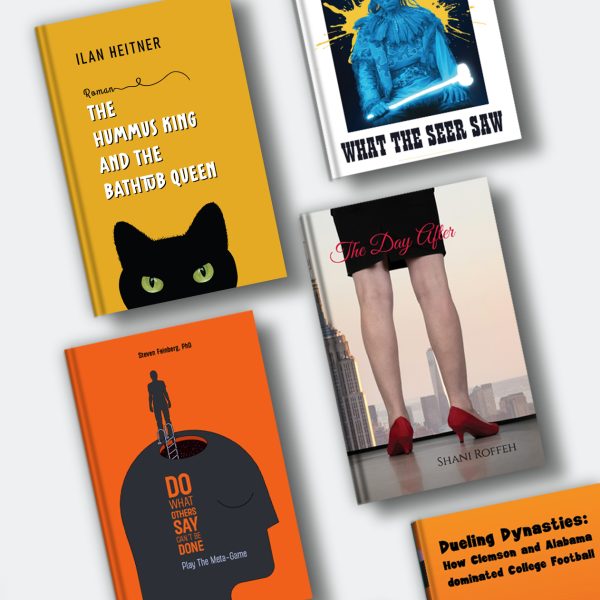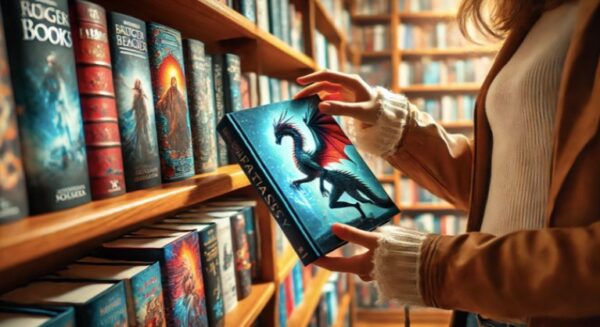In the publishing world, a book cover is like a book’s online dating profile—it gets just a few seconds to make a lasting first impression. A great cover can make readers swipe right, while a lackluster one risks being ghosted on the shelf. Despite the timeless advice to “never judge a book by its cover,” the reality is quite the opposite: a book’s cover often decides whether it’s picked up, clicked on, or left in literary limbo.
Book cover design is a blend of art, psychology, and marketing wizardry. It’s the process of packaging a story’s soul into an image so compelling that readers can’t resist exploring further. The cover—typically adorned with the title, author’s name, and an enticing visual—is the handshake, the elevator pitch, and the book’s first flirtation with its audience. A well-designed cover doesn’t just attract attention; it whispers, “This is the story you’ve been looking for,” while subtly hinting at the book’s genre, tone, and essence.
Behind every captivating book cover is a blend of creativity and strategic thinking. Book cover designers are tasked with interpreting the book’s narrative and themes into an appealing and coherent visual format. They play a pivotal role in translating an author’s written words into a powerful visual story that resonates with and captivates potential readers. As we delve deeper into the nuances to design a book cover, and we’ll explore how these visual masterpieces are crafted and why they are indispensable in the journey of a book from manuscript to bestseller.
Elements of a Stunning Book Cover Design
A remarkable book cover design is not just an artistic endeavor but a strategic amalgamation of various elements that collectively create an enticing visual appeal. These elements include bold typography, captivating imagery, a harmonious color scheme, and a well-thought-out layout. Each plays a vital role in crafting a front cover image that not only stands out but also resonates with the book’s genre and target audience.
Bold Typography
Typography is a powerful tool in book cover design, often being the first element that catches a reader’s eye. Bold typography isn’t just about using heavy or large fonts; it’s about making a statement. The choice of font, size, and color should complement the overall design and genre of the book. For instance, a thriller might use sharp, angular typefaces to evoke a sense of suspense, while a romance novel might opt for elegant, flowing scripts. The key is to ensure that the title is legible and the style of the text aligns with the book’s tone.
Captivating Imagery
Imagery is the visual centerpiece of a book cover. It can be an illustration, a photograph, or a graphic design element that encapsulates the essence of the book. This imagery should tell a story, hinting at the narrative or the theme of the book. It’s crucial that the imagery doesn’t overpower the text but rather complements it, creating a cohesive and balanced design.
When selecting images, authors have the choice between using custom illustrations, their own images, or stock photos. Custom illustrations offer uniqueness and a personal touch, often resonating more with specific genres like fantasy or children’s books. Own images can add a personal or autobiographical element, making the book feel more intimate. Stock images are a cost-effective and time-saving option, but it’s vital to choose ones that don’t feel generic and are tailored to fit the book’s theme.
Harmonious Color Scheme
Color plays a pivotal role in setting the mood and tone of the book cover. The color scheme should reflect the emotions and themes of the book. Warm colors can evoke feelings of passion or excitement, while cooler tones might suggest mystery or calmness. It’s important to ensure that the color palette is visually appealing and enhances both the imagery and typography.
Well-Thought-Out Layout
The layout of a book cover involves the strategic placement of each element, ensuring a balanced and harmonious composition. The title, author’s name, imagery, and other textual elements like subtitles or quotes need to be arranged in a way that is aesthetically pleasing and easy to navigate. The layout should guide the reader’s eye across the page of the cover, creating a visual journey that culminates in an understanding of what the book might offer.
Your Publishing Journey Awaits – Start NowThe Role of Professional Book Cover Designers
The crafting of a book cover is an art that requires more than just an aesthetic sense; it demands a fusion of marketing acumen, design expertise, and a deep understanding of the publishing industry. This is where professional book cover designers come into the picture, bringing with them a repertoire of skills that elevate a book’s visual appeal to professional standards.
Expertise and Skills of Professional Designers
Professional cover designers possess a nuanced understanding of design principles, typography, color theory, and imagery. Their expertise extends beyond mere artistic talent; they are adept at interpreting a book’s essence and translating it into a visual narrative that can engage potential readers at first glance. These designers are also well-versed in current market trends, enabling them to create covers that are not only beautiful but also commercially viable.
DIY vs. Professionally Designed Covers
The difference between DIY and professionally designed covers can often be stark. While DIY covers might be cost-effective, they may lack the polish and sophistication of a professional design. Amateur designs often fall short in terms of technical quality, with issues in resolution, typography, and overall balance. In contrast, a professionally designed cover is meticulously crafted, keeping in mind the nuances of both digital and print mediums. These covers stand out for their clarity, professional finish, and alignment with the book’s target market.
Catering to Ebooks and Print Books
Professional book cover designers skillfully navigate the requirements of both ebooks and print books. For ebooks, designers focus on creating covers that are impactful even at thumbnail size, ensuring legibility and appeal in digital storefronts. For print books, designers consider additional aspects such as spine design, back cover, and the overall physical feel of the cover. They are adept at adjusting designs to fit various print formats – whether it’s a paperback, hardcover, or a dust jacket – and understand the technicalities involved in print production, such as spine width calculations and bleed settings.

Custom Book Cover Design for Self-Publishers
Self-publishing has revolutionized the literary world, offering authors more control over their work. However, it also presents unique challenges and opportunities, especially in the realm of book cover design. A custom book cover is a critical component in the success of self publishing online, as it often determines the first impression and marketability of the work.
Challenges and Opportunities
One of the primary challenges for self-publishers is the need to stand out in a saturated market. Without the marketing machinery of traditional publishing houses, the cover becomes an even more crucial tool for attracting potential readers. However, this challenge is also an opportunity for creativity and personalization. Self-publishers have the freedom to explore and express their vision for their book’s cover without the constraints often imposed by traditional publishers.
Collaboration with Designers
Collaboration with professional designers is a viable path for self-publishers seeking custom book covers. This partnership allows authors to bring their vision to life with the expertise of a designer. Self-publishers need to communicate their ideas, themes, and expectations clearly, while also being open to the designer’s creative suggestions. A successful collaboration involves a mutual understanding of the book’s target audience and market positioning.
Understanding Technical Requirements
For self-publishers, it’s crucial to have a grasp of the technical requirements of book cover design, especially for print books. This includes understanding the printing process, spine width calculations, and bleed settings. The spine width depends on the number of pages in the book and the paper type, and getting this wrong can lead to unprofessional results. Additionally, knowledge of resolution, color settings (CMYK for print, RGB for digital), and file formats (like PDF for print) is vital for ensuring the cover looks as intended when printed.
Your Publishing Journey Awaits – Start NowDesign Process: From Concept to Final Cover
The journey from a mere concept to a final, complete, polished book cover is a meticulous and collaborative process involving several key steps. This journey not only requires creativity and technical skill but also a deep understanding of the book’s essence and the author’s vision.
Step 1: Brainstorming and Conceptualization
The design process begins with brainstorming and conceptualization. This stage is about understanding the book’s core themes, target audience, and the author’s expectations. It often involves discussions between the author and the designer to align thoughts and ideas. This collaborative effort sets the groundwork for the design, with the exchange of ideas, mood boards, and possible design directions.
Step 2: Sketching and Mock-ups
Once the initial ideas are set, the designer starts sketching or creating digital mock-ups. This phase transforms abstract concepts into tangible visual representations. It’s an exploratory stage, where multiple designs might be conceived to see which best captures the book’s spirit. These sketches or mock-ups are then presented to the author for feedback, ensuring that the design aligns with their vision.
Step 3: Selecting Images and Typography
The next step involves selecting the right images, color palette, and typography. This selection is crucial as it significantly influences the cover’s appeal. The designer might use stock images, custom illustrations, or photographs, depending on the book’s genre and the cover’s concept. Similarly, choosing the right font and color scheme is essential to convey the appropriate mood and style.
Step 4: Finalizing the Layout
With the key elements selected, the designer then works on finalizing the layout. This involves fine-tuning the placement of the title, author’s name, imagery, and other textual or graphical elements. The layout must be aesthetically pleasing and balanced, ensuring legibility and visual impact.
Step 5: Review and Revision
The final and perhaps most critical stage is the review and revision process. The author is presented with the near-final design and is invited to provide feedback. This stage is about refining the cover, making adjustments, and addressing any concerns the author might have. The goal is to reach a point where the author is completely satisfied with the cover, as it not only represents their book but also their personal brand.
Step 6: Copyright Protection for Cover Art
Once the cover design is finalized and approved by the author, the crucial step of copyright protection for your cover comes into play. This involves ensuring that the artwork, including any custom illustrations, photographs, and unique typographic elements, is legally protected against unauthorized use. The designer or the author can register the cover art with the relevant copyright office, securing a copyright that safeguards their creative work. This formal step provides legal recourse in the event of infringement and reinforces the cover art’s status as a unique and valued intellectual property.
The design process of a book cover is a collaborative and iterative journey, involving brainstorming, sketching, selecting images and typography, finalizing details of the layout, and undergoing review and revisions. It’s a process that combines the creative vision of the author with the technical and artistic expertise of the designer, culminating in a cover that encapsulates the essence of the book and appeals to its intended audience.
Essential Tips for Creating a Great Book Cover
Crafting an effective book cover is a delicate balance between artistic expression and strategic design. While the front cover often grabs the initial attention, the overall design, including the spine and back cover, plays a crucial role in the book’s appeal. Here are some essential tips for creating a great book cover:
Effective Use of Text Boxes and Spine Text
- Text Boxes: The placement of text boxes for the title, author’s name, and any other textual information should be strategic. Ensure that these elements do not clash with the imagery but rather complement it. The font choice and color should enhance readability and attract attention without overpowering the overall design.
- Spine Text: For print books, the spine is an often overlooked but vital space. The text on the spine should be legible and well-aligned. Remember, in many bookstores, the spine is the first and only part of your book that a reader might see. The title and author’s name should fit comfortably, with the font size adjusted according to the spine’s width.
Significance of High-Quality Design for Front and Back Covers
- Front Cover: This is the most visible part of the book and should be striking and relevant to the book’s content. The imagery and typography should work together to create an inviting and intriguing front.
- Back Cover: The back cover is equally important, especially for print copies. It typically contains a blurb that should be concise and engaging, an author bio, an ISBN, and sometimes reviews or endorsements. The layout should be clean, and the text should be easily readable. The design should maintain the style and color scheme of the front cover for consistency.
Incorporating Feedback
- Potential Readers or Focus Groups: One of the most valuable steps in designing a book cover is gathering feedback from potential readers or focus groups. Their insights can provide invaluable perspectives on how the cover is perceived. Does it convey the right genre? Is it appealing? Does it stand out? Such feedback can be crucial in making final adjustments that significantly enhance the cover’s effectiveness.
Creating a great book cover is a nuanced art that involves careful consideration of every element, from typography to layout, and a keen understanding of the target audience. By paying attention to these tips and incorporating feedback, authors and designers can create compelling covers that capture the essence of the book and draw readers in.

AI in Book Cover Design
In today’s rapidly evolving technological landscape, Artificial Intelligence (AI) has emerged as a transformative force, revolutionizing the way we approach cover design. AI-powered tools have unlocked a world of creative possibilities, effortlessly generating a myriad of design options that capture the essence of a book with remarkable precision. Platforms like Spines, who offer self-publishing services, exemplify this innovative approach, offering authors the opportunity to harness the power of AI to craft covers that not only captivate but also effectively convey the essence of their literary creations.
AI’s ability to analyze vast amounts of data and identify trends is invaluable in understanding which visual elements resonate most with readers across different genres. It can suggest color schemes, layouts, and imagery likely to appeal to a specific audience, drawing on successful past designs. This technology assists in creating initial concepts, and quickly generating varied designs based on the book’s genre, target audience, and themes. These can then be refined by human designers, blending AI efficiency with creative human insight.
Moreover, AI streamlines the design process by efficiently sorting through stock images and automating aspects like image resizing and layout adjustments. However, despite these advancements, the human element in cover art remains crucial. AI aids in design but doesn’t replace the nuanced understanding of a skilled human designer. As AI evolves, its role in complementing human creativity in book cover design is becoming increasingly significant, marking a new era in how we visually present literary works.
Spines stands as a shining example of innovation in the publishing industry, harnessing the potential of AI to revolutionize the way books are published and presented. This innovative AI-powered publishing platform offers a comprehensive suite of services, guiding authors through the intricacies of getting their works published with unparalleled ease.
Comparing AI and Traditional Cover Design
AI cover design offers distinct advantages over traditional methods, primarily in efficiency and data-driven precision. Unlike the time-intensive nature of traditional design, AI can rapidly generate multiple concepts, drawing from extensive data on market trends and reader preferences. This leads to designs that are not only created faster but are also tailored to appeal more effectively to specific target audiences. AI’s ability to analyze and implement current design trends can result in covers that are more aligned with contemporary reader expectations. While traditional design relies on individual expertise and intuition, AI brings a level of analytical insight and speed that can significantly enhance the cover creation process, making it a valuable tool in the evolving landscape of book publishing.
The significance of a well-designed book cover in determining a book’s success cannot be overstated. It’s the first point of engagement with potential readers and plays a crucial role in conveying the essence of the content within. The advent of AI in book cover design has revolutionized this domain, offering sophisticated, data-driven solutions that enhance both the efficiency and appeal of cover designs. The blend of AI advancements with the creativity of professional designers proves most effective. Authors are encouraged to invest in this synergy of technology and professional expertise to ensure their book covers make a lasting and impactful first impression.








